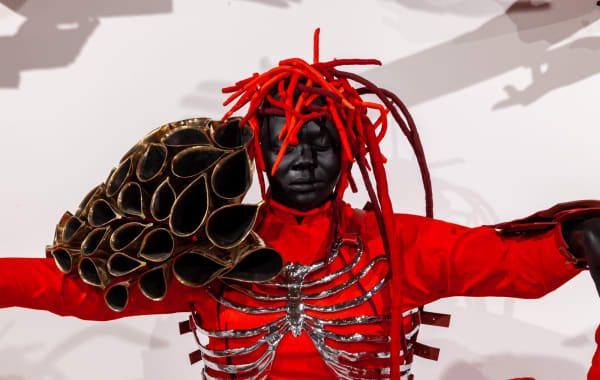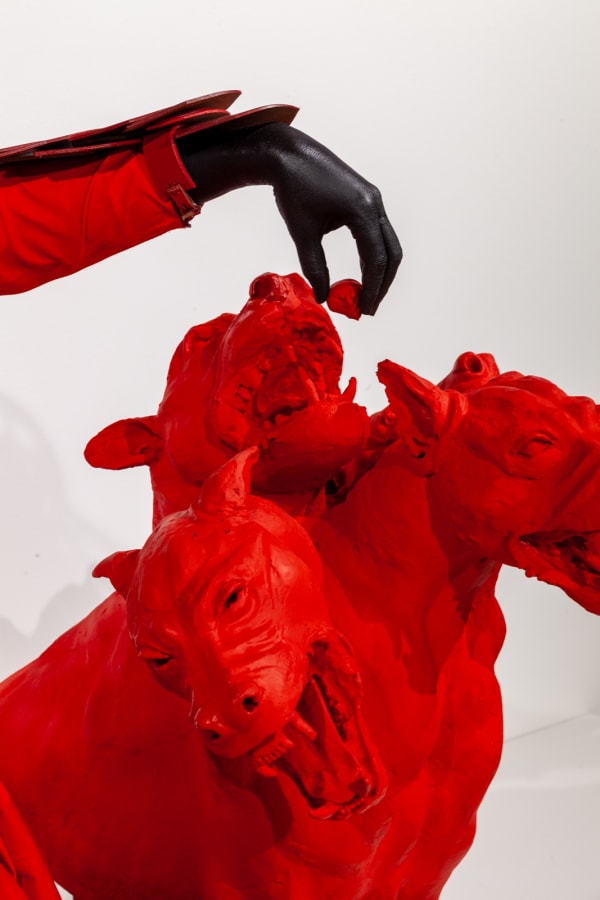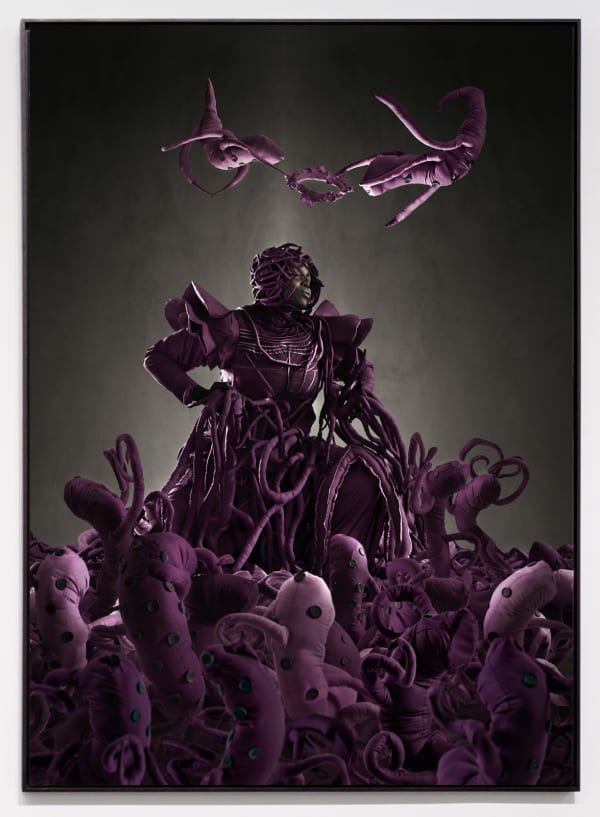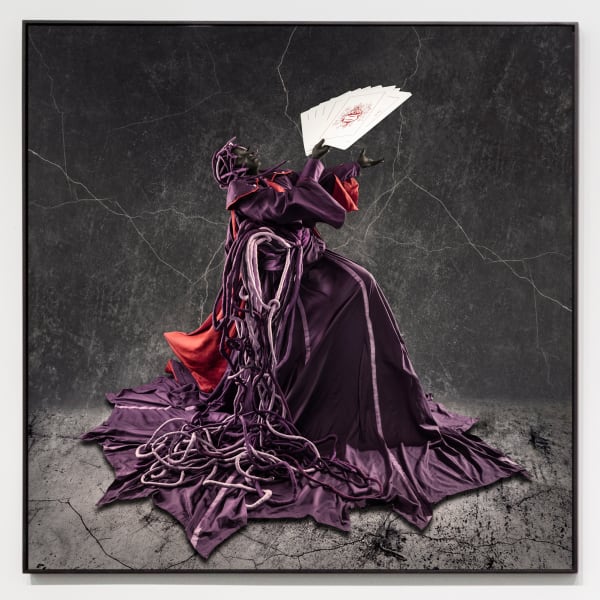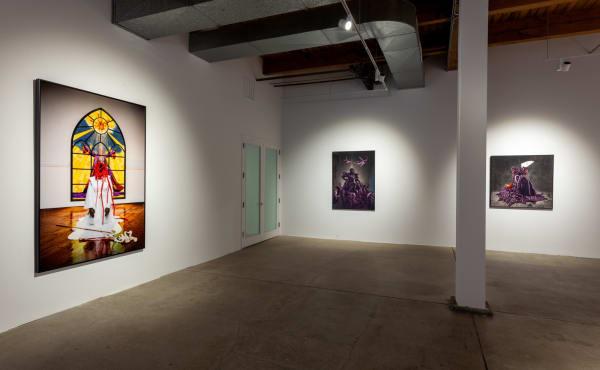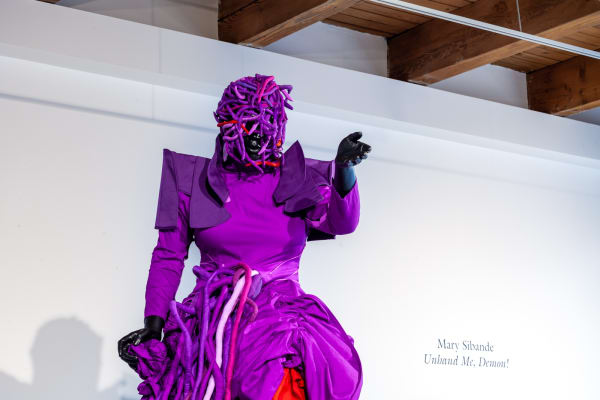-
-
Unhand Me, Demon! brings together for the first time in the United States 13 years of work by renowned South African artist Mary Sibande. Inaugurating Kavi Gupta’s new street-level space at 835 W. Washington Blvd. in Chicago, the exhibition examines a crucial question of our time: How do we shed negative energies and move forward when we find ourselves at a crossroads in life?
The impetus for the name of the show, Sibande says, was the legend of blues singer Robert Johnson, who allegedly mysteriously transformed in a matter of weeks from someone with almost no ability into one of the greatest blues guitarists of all time. People claimed Johnson made a deal with the Devil, selling his soul for talent at the crossroads of Highways 49 and 61 in Mississippi. Modern research reveals the true source of Johnson’s transformation was hard work under the tutelage of blues guitarist Isaiah "Ike" Zimmerman, who gave Johnson lessons in a cemetery late at night, where they would not be bothered.
“Crossroads are about cutting away the old life for something new,” says Sibande. “The demon for me, if I were to translate it from my home language, would be bad energies, or a thing that’s holding you, or pulling you back. This show is about letting go, a preparation for going forward. As an individual, one has to shed some things like a snake.”
Like the Robert Johnson story, Sibande’s oeuvre is rooted in a space where intelligent effort intersects with, and is sometimes confused with, magical thinking. The work centers a character named Sophie, whom Sibande describes as her alter ego or avatar. Sophie’s mythology is an autobiographical representation of chapters in Sibande’s life, as she witnesses and participates in the evolving social, political, and cultural roles of Black women in the aftermath of Apartheid in South Africa.
-
-
-
The Domba Dance (2019) shows Sophie arriving fully in the Red Phase, unleashing dogs of war; while Ascension of the Purple Figure (2016), Right Now! (2015), and Wielding the Collision of the Past, Present, and Future (2017) bear witness as Sophie moves from protest into empowerment.
-
-
Placing Sophie within different narratives and contexts, coded through color, Sibande mobilizes photography, sculpture, and installation to explore issues of domestic labor (the Blue Phase), protest and revolution (the Purple Phase), and, in her latest body of work, issues of blood, anger, and empowerment (the Red Phase).
-
-
Sophie’s most recent transformation is further expressed in two images titled To everything there is a season (2019) and Turn, turn, turn, turn (2019), which attest to a spiritual cleansing.
-
A Terrible Beauty is Born (2013) show Sophie dressed elegantly in a flowing purple dress, surrounded by throngs of embryo-like purple creatures—a reference to the Purple Rain Protests in South Africa, and the subsequent birthing of a new generation of civil rights activists.
-
Together, the works in Unhand Me, Demon! offer a broad overview of the evolution of Sibande’s studio practice up to this point. The show also lays the groundwork for what Sibande says will be the next crossroads, as her avatar Sophie moves into the Green Phase, suggestive of rebirth. “It’s time to hit the restart button,” Sibande says. Accompanying the exhibition, Kavi Gupta is proud to premiere a new short-form documentary filmed on location in Johannesburg, further elucidating Sibande’s studio practice, methods, and concepts.
-
About the Artist
Mary Sibande (b. 1982, South Africa) is a sculptor, painter, and installation artist whose work not only interrogates the current intersections of race, gender, and labor in South Africa, but actively rewrites her own family’s legacy of forced domestic work imposed by the then-Apartheid state. Through photography and sculpture, Sibande employs the human form as a vehicle for a focused critique of stereotypical depictions of women, particularly Black women in South Africa. For Sibande, the body is the site where history is contested and where Sibande’s own fantasies can play out.
This counter-history takes the form of an alter-ego in Sibande’s work, a persona by the name of Sophie, who is dressed in various uniforms that resemble those worn by domestic workers. Turning these dress styles into Victorian motifs, Sibande reanimates Sophie’s history in the ways her body is adorned and occupies the narratives that were stolen from and denied to her. This is not just a political act, but one of transformation, as Sophie takes on new incarnations of herself unbound from the history of servitude and labor that extends into the present’s domestic relationships. Transitioning from blue to purple to red, Sibande introduces us not only to the many faces of herself and Sophie, but to the complex personhoods of African women who continue to create worlds and narratives outside of the Western imperialist canon.
Based in Johannesburg, Sibande has taken part in the 2011 Venice Biennale as the representative of South Africa; Lyon Biennial; Dakar Biennial; and Havana Biennial, among others. She has exhibited internationally in leading museums, including the Met Breuer, New York, USA; British Museum, London, UK; Zeitz MOCAA, Cape Town, South Africa; JAG (Johannesburg Art Gallery), Johannesburg, South Africa; Boston Museum of Fine Art, Boston, USA; Musée d’art Contemporain de Lyon, France; Iziko South African National Gallery, Cape Town, South Africa; Museum of Contemporary Art, Rio de Janeiro, Brazil; Kiasma Museum for Contemporary Art, Helsinki, Finland; Museum Beelden aan Zee, Hague, Netherlands; and Somerset House, London, UK, among others. Sibande’s works are included in prominent collections internationally, such as the Smithsonian National Museum of African Art, Washington, DC, USA; Virginia Museum of Fine Art, Richmond, USA; Norton Museum of Art, Palm Beach, USA; UMMA (University of Michigan Museum of Art), Ann Arbor, USA; Museum of Contemporary Photography, Chicago, USA; Zeitz MOCCA, Cape Town, South Africa; Musée d’Art Contemporain du Val-de-Marne, France; and Iziko South African Museums, Cape Town, South Africa. Forthcoming exhibitions include Mary Sibande: Blue Red Purple at the Frist Art Museum, Nashville, USA, and her work is currently on view at Frac Nouvelle-Aquitaine MÉCA in Bordeaux, France.



